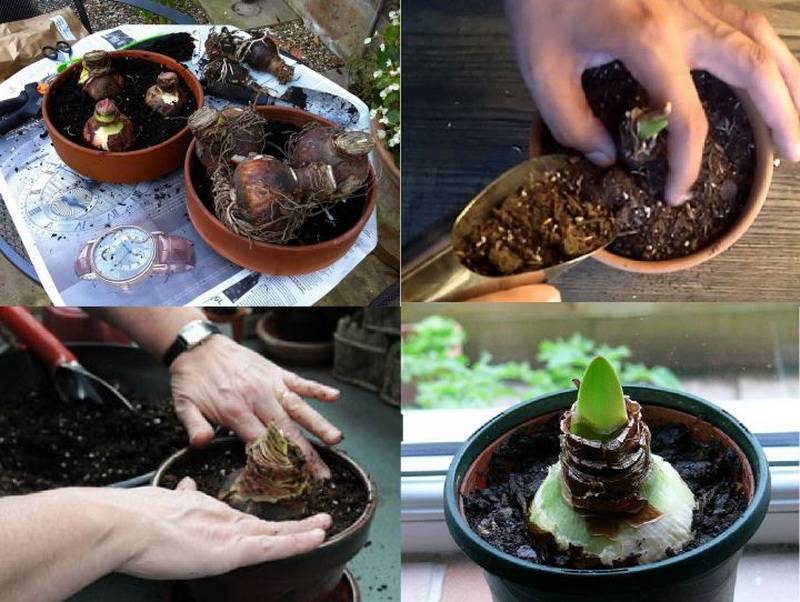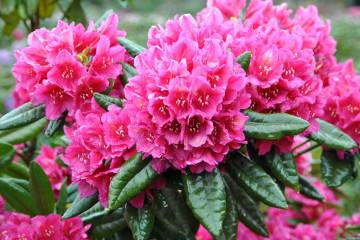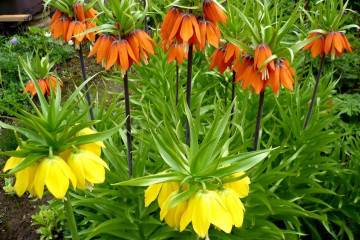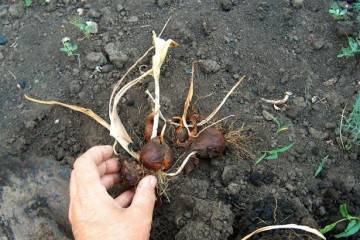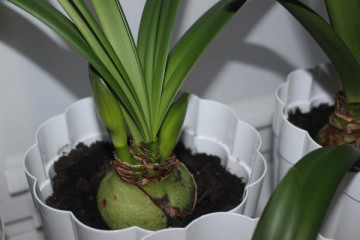Hippeastrum - home care before and after flowering
Content:
The Amaryllis family has more than 90 species. Only a few representatives of this spectacular family are suitable for growing at home. Among them is hippeastrum. This bulbous plant grows in the tropics and subtropics of the American continent, as well as in the central and southern parts of distant Africa, from where it was brought to the European continent at the turn of the 16-17 centuries.
Description of the plant
The bulb of this perennial has a spherical shape, but in rare cases it can also be in the form of a cone. The diameter of the bulb depends on the species and varies from 50 to 100 mm. There may be small roots on the base. The stem is short and thick with well-detachable scales.
Leaves are belt-shaped, grooved-keeled. The length of the leaf can reach 70 cm, while the width is only 4-5 cm. Usually they are bright green, but sometimes they can have a burgundy color at the base. The leaves of the hippeastrum are collected in 2 opposite rows.
The peduncle is hollow, leafless, tubular. It can be either low - 30-35 cm, or very impressive - 75-80 cm. The inflorescence usually consists of 2, 4 or 6 bisexual funnel-shaped or tubular buds.
After the plant has faded, the fruit appears, which is a small box, similar to a miniature cocoon. It contains small seeds. By the way, they have excellent germination.
Hippeastrum: home care
Hippeastrum flowers are hardly suitable for those who have no experience in caring for bulbous plants. Thoughtless watering and the lack of adequate conditions during the dormant period will quickly send the flower to the compost heap. But if you approach the care with all responsibility, you can get a real decoration in the collection of home flowers.
Lighting
Hippeastrum is a flower that prefers bright light. However, direct sunlight, if exposed to leaves, can cause burn damage. The container with the bulb must be placed on the windowsill of any window, except for the one that faces north. It is useful to regularly rotate the plant around its axis to avoid tilting or asymmetry of the flower.
Temperature regime
The temperature during active vegetation should be strictly between 17-26 ° C. Sudden temperature changes can be detrimental to the flower. Despite the fact that hippeastrum is an indoor flower, in the warm season it can be taken out into the fresh air, not forgetting to take care that excess moisture does not accumulate in the place of its location.
Watering
The intensity of watering depends on the growing season. At the very beginning of this process, water should be little or not at all, replacing watering with soil irrigation.
When the first signs of peduncle formation appeared, this means that the growing season has begun and it is necessary to increase watering. During the formation of buds, water the hippeastrum must be watered abundantly. However, it should be remembered that stagnant moisture can lead the plant to death.For a plant like hippeastrum, the best way to water is a tray filled with warm soft water.
Top dressing
When the height of the peduncle reaches 15 cm, the soil substrate must be shed with a weak solution of manganese. And after a week, the hippeastrum should be fed with fertilizer containing phosphates.
Subsequent feeding should be done every two weeks. Moreover, at the stage of formation of leaf plates, it is necessary to apply fertilizers for decorative deciduous indoor flowers, and when flowers appear, this fertilizer should be replaced with feeding for flowering plants.
Hippeastrum - transplant
Hippeastrum does not need frequent transplants. It will be correct to transplant it every few years, after the plant has faded and begins to prepare for rest. This flower does not need too wide a pot. There will be enough of such a size that from the wall to the bulb is 2 cm.
Despite the fact that there is not so much soil in the pot, there are still very specific requirements for its composition. The soil is prepared from coarse sand, humus, leafy substrate and turf. Before transplanting the hippeastrum bulb, the soil mixture should be sterilized. Before planting, drainage (pebbles, glass balls, expanded clay) must be laid on the bottom of the container.
Reproduction
Hippeastrum can multiply in three ways: by seed, vegetatively and by dividing the onion.
Seed propagation
If a method of propagation by seeds is chosen, then it should be borne in mind that only fresh seeds have good germination. Dried up seed loses this ability and is equal to only 25-30%. In addition, in order to obtain seed material, it is required to carry out artificial pollination. As a rule, this breeding method is rarely used, as it takes a huge amount of time.
Reproduction by baby bulbs
It is quite simple to propagate hippeastrum vegetatively. You just need to separate the baby from the adult bulb. This is usually done at the time of transplant using a sharp, disinfected instrument.
After the baby is separated, sprinkle the cut with wood ash. It is recommended to grow as usual, but not to cut the leaflets from a young plant for two years.
Reproduction by dividing the bulb
This method is usually chosen if the plant is a hybrid. The most suitable month for manipulating the bulbs is November. It is in this month that the largest amount of nutrients is concentrated in the bulb. The top layer of soil is removed while the bottom of the bulb remains in the soil. The foliage and scales are trimmed, and the bulb itself is divided into 4 equal parts. Moreover, the cuts must be made to the level of the soil.
Plastic expanders are inserted between the lobes, pushing them apart by 5-6 cm. Follow-up care is carried out as usual, constantly making sure that the soil does not dry out.
Dormant period
The resting period of the hippeastrum begins in early autumn and ends in January-February. Watering should be stopped by September, the leaf plates should be cut off. The pot with the bulb is placed in a dark, well-ventilated place and laid horizontally. There he will be for several months, while the temperature regime should be in the range from 6 to 12 ° C. At the end of January, the container with the onion is removed into the light and watering begins.
Hippeastrum: toak care to bloom
Florists who have rich experience in growing hippeastrum are advised to resort to some secrets in order to achieve abundant flowering:
- Before planting the onion in the mixture prepared for it, it must be soaked in warm, almost hot water (45 ° C). This procedure stimulates the appearance of flowers after 20-25 days.
- Watering the hippeastrum stops already in August.
- The flower is taken out to the windowsill in the house only at the beginning of January. From this point, you can count 4-6 weeks before flowering.
- If you want to get a lush flowering in August-September, then in the middle of summer all leaf plates are removed from the bush, watering stops for a month. After a month after the first watering, you need to apply fertilizer.
Why hippeastrum flowers don't bloom
The most common reason for the lack of flowers is a lack of nutrients due to depleted soil. Therefore, unlike other indoor plants, timely fertilization is the main condition for the plant to actively bloom.
Diseases and pests
If you provide care for the hippeastrum, then most likely diseases, pests and other health-threatening factors will bypass the plant. In the case of a careless attitude towards a tropical flower beauty, he will fall ill with diseases that are extremely difficult to treat. Among the most unpleasant:
- brown rot;
- downy mildew;
- red fungus burn (stagonosporosis).
The above painful conditions of a flower most often appear because the watering regime is violated.
To diagnose a problem, you need to carefully examine the plant. The presence of rot will be indicated by a changed color, signs of plaque on the leaf plates, wilting of foliage.
What to do if the flower is sick
If the damage to the plant is extensive, then it makes sense to replace it with a new one. If the first minor signs are observed, then you can try to save the plant by applying fungicides. Before processing, the affected areas must be removed from the bulbs.
Hippeastrum: how to care if the plant is attacked by pests
Sometimes the reason that the plant does not want to bloom in any way is the attack of the seaside mealybug - the most common representative of this type of harmful insects. These pests are able to suck out all the juices from the flower in a short time. In addition, the worm can cause black mold infestation on the plant. Usually all parts of the plant are affected.
The amaryllis worm stops the growth and development of the flower. In the event of damage to this insect, the hippeastrum may bloom ahead of time, and sometimes even not release the arrow-peduncle at all.
If a scale insect is found on a flower, then the plant must be immediately isolated from other indoor inhabitants. These insects affect the entire ground part of the plant, first damaging the edges of the leaves, then spreading over their entire surface.
The treatment is complicated by the fact that the hard shell protects the insect from the effects of even the most active insecticides. Therefore, manual collection of pests is practiced first, and only then treatment with chemicals.
Hippeastrum will definitely appreciate home care. It is ensured, first of all, by strict adherence to the cycles of rest and active vegetation. If you ignore this principle of existence, which is important for a plant, you can quickly lose this tropical beauty.


